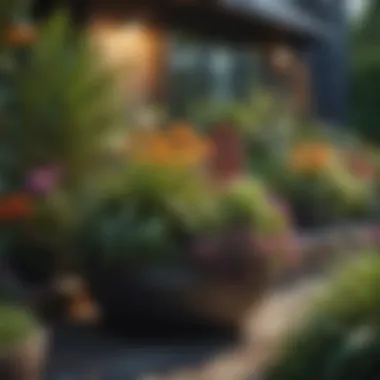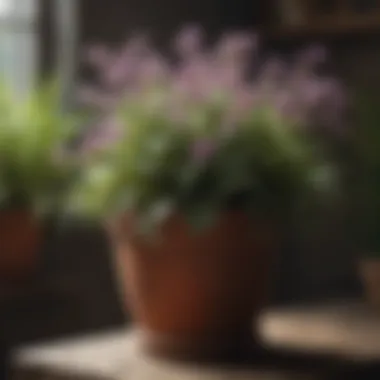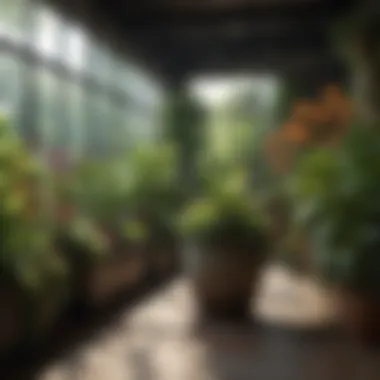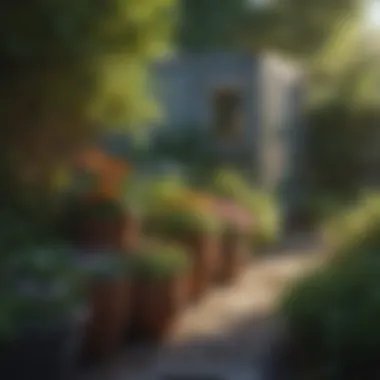Choosing the Best Perennials for Your Container Garden


Intro
Container gardening offers a unique opportunity for both novice and seasoned gardeners. This approach allows individuals to bring lush greenery and vibrant colors into their living spaces, irrespective of the size or condition of their outdoor environment. Perennials are particularly appealing for container gardening due to their ability to thrive in various conditions and return season after season. However, choosing the right perennials involves a careful consideration of several factors. This article will delve into the essential components of selecting suitable perennial plants for pots, covering their benefits, ideal characteristics, and practical care tips.
By focusing on effective design inspirations, gardening techniques, and maintenance advice, readers will find the essential guidelines for cultivating a flourishing container garden that enhances their homes and lifestyle.
Design Inspiration
When considering container gardening, design inspiration is crucial. Creating an appealing look requires understanding current trends in interior design and how they relate to botanicals.
Current Trends in Interior Design
The current trend is towards integrating nature into living areas to promote tranquility and well-being. Natural aesthetics are prominent, with many homeowners opting for minimalist designs that allow floral elements to stand out. The use of tailored containers and strategic plant placement enhances indoor or outdoor spaces, making perennials an ideal fit.
Common features include:
- Natural materials: Wood, ceramic, and recycled materials for pots.
- Sustainability: Emphasis on eco-friendly practices encourages using perennials, as they last longer than annuals.
- Mixed arrangements: Grouping varying species can create striking contrasts.
Color Schemes and Palette Ideas
The color of container plants can transform spaces. Choosing complementary or contrasting hues can energize or calm the environment. For example:
- Warm tones: Plants with reds, oranges, and yellows can create a warm, inviting space.
- Cool tones: Blues, purples, and whites can instill a sense of peace.
- Monochromatic schemes: Various shades of one color can add depth and sophistication.
When selecting colors, ensure they align with your overall decor and the desired ambiance of the space.
Gardening Techniques
Aspects of gardening techniques play an essential role in the success of container gardening. The process begins by selecting the right plants and understanding their specific care requirements.
Plant Selection and Care
When choosing perennials for containers, consider climate, size, and light exposure. Some ideal species include:
- Lavender: Resistant to drought and attracts pollinators.
- Hosta: Works well in shaded areas and adds lush foliage.
- Daylily: Drought-resistant with a variety of colors.
Ensure proper care and maintenance by watering regularly, checking for pests, and using appropriate fertilizers. Over time, this attention will help achieve a bountiful container garden.
Indoor vs. Outdoor Gardening
The choice between indoor or outdoor container gardening significantly influences the plant selection process. Outdoor gardens may offer more sunlight, while indoor gardening requires plants adaptable to lower light conditions. Understanding the specifics of each environment can amplify success.
"A well-chosen perennial can blossom each year and create lasting beauty in any container."
Incorporating these considerations into your gardening strategy will allow you to develop a garden that not only thrives but also enhances your living spaces aesthetically and functionally.
Intro to Container Gardening
Container gardening has emerged as a vital aspect of modern horticulture, allowing individuals to cultivate plants in a variety of environments, particularly where ground space is limited. This method is especially appealing for homeowners, interior design enthusiasts, and gardening aficionados. The ability to grow plants in pots not only enhances aesthetic values but also provides practical solutions for urban living where traditional gardening may not be feasible.
When considering the dynamics of container gardening, one must recognize the flexibility it offers. It empowers individuals to create gardening spaces in balconies, patios, and small yards. Moreover, the practice caters to diverse lifestyles, enabling easy mobility and the ability to change plant arrangements as desired. Such adaptability is critical, as it allows for creative expression through planting designs. For those planning events or parties, container gardens can serve as impactful focal points that transform outdoor and indoor spaces.
Defining Container Gardening
Container gardening refers to the practice of growing plants in containers instead of planting them directly in the soil. This technique encompasses various forms and styles, from simple flower pots to elaborate planter boxes. A pot can be any vessel that holds soil and provides drainage, making it a versatile option for plant growth.
Container gardening is not limited to ornamental plants; one can also cultivate vegetables, herbs, and even fruits. The container serves as both a habitat for the plants and a potent decorative element in one’s living area. This method is suitable for both novice and seasoned gardeners, offering a practical approach that eliminates some of the challenges of traditional gardening.
Benefits of Using Containers
The advantages of container gardening are numerous:
- Space Efficiency: Ideal for areas with limited ground space.
- Control Over Grow Environment: Easier to manage soil quality, moisture, and nutrients.
- Aesthetic Versatility: Containers can complement outdoor or indoor decor.
- Mobility: Easily rearranged to enhance visual appeal or to change the landscape with the seasons.
- Accessibility: No bending down or kneeling is required, which can be beneficial for those with physical constraints.
Container gardening offers a unique opportunity to blend aesthetics with practical plant growth, appealing to a diverse audience.
Understanding Perennials and Their Role
Understanding the role of perennials in container gardening is essential. Perennials, known for their ability to return year after year, provide stability and continuity in a garden. Unlike annuals that require replanting each season, perennials save time and resources. This aspect appeals especially to homeowners with busy lifestyles, allowing them to enjoy beautiful blooms and lush foliage without constant effort.
Perennials also contribute positively to the aesthetics of container gardening. Their varied colors, sizes, and textures can create stunning visual contrasts and cohesion. Knowing how to select the right perennials can lead to a diverse and engaging outdoor space that evolves with the seasons.
What Are Perennials?
Perennials are plants that live for more than two years. Unlike annuals, which complete their life cycle within a single growing season, perennials establish robust root systems. This allows them to survive adverse conditions and bloom reliably year after year. Wood-based plants like shrubs and some trees also fall into the perennial category, but for containers, herbaceous perennials are most common. They die back in winter and regrow in spring or early summer.
Understanding this lifespan is crucial for gardeners. It means that once established, perennials can provide ongoing beauty with less repetitive planting. Moreover, they often require less water and care compared to other types of plants, making them a wise choice for busy gardeners.


Advantages of Perennials in Pots
Using perennials in containers has several advantages:
- Longevity: Perennials return each year, which means your investment lasts longer.
- Less Maintenance: Once established, these plants typically require minimal care compared to annuals.
- Diverse Options: They come in countless varieties, providing flexibility in color, height, and texture.
- Seasonal Interest: Different perennials bloom at various times, so your container can look appealing throughout the year.
"Perennials are an excellent choice for gardeners who appreciate an evolving landscape without extensive work each season."
These elements make perennials particularly well-suited for container gardening. They transform outdoor spaces, adding life and color, and improving the overall enjoyment of your environment.
Selecting the Right Perennials for Potting
Choosing the right perennials for potting is essential in container gardening. This choice directly impacts the aesthetics, growth success, and overall health of the plants. The right perennials can bring longevity and vibrant life to your containers, while poor selections may lead to disappointing results.
A variety of factors influence the selection process. One consideration is the plant's growth characteristics. Some perennials spread and grow more aggressively, while others maintain a more compact form. Understanding these aspects helps in avoiding overcrowding or a chaotic look in containers.
Light requirements form another critical point. Each perennial has specific light needs that can determine its growth and flowering patterns. Additionally, soil needs play a significant role in the success of container gardening. The right soil mix can enhance drainage and nutrient availability, both necessary for healthy plants. Finally, size constraints cannot be overlooked. Selecting plants that fit within the dimensions of your container ensures they thrive without becoming root-bound or stunted.
Key Characteristics to Consider
Growth habit
The growth habit of perennials defines how they develop and spread over time. It involves understanding whether a plant is clumping or spreading. Clumping perennials, like hostas, tend to grow in compact mounds, which makes them good for smaller containers. They provide a tidy appearance and their growth is easy to manage. On the other hand, spreading perennials may take over and require more space. This characteristic matters because it influences the arrangement of plants in your container and how they interact visually. Choosing the right growth habit helps in maintaining a balanced and attractive container garden.
Light requirements
Different perennials have distinct light preferences, which directly affect their growth and flowering success. For example, sun-loving plants such as Coreopsis need at least six hours of direct sunlight daily, while others like Astilbe thrive in partial shade. Understanding these light requirements helps you place your containers in the most suitable location. Furthermore, this contributes to the overall health of the plant, as insufficient light can lead to leggy growth and fewer blooms. Proper assessment of light conditions will enable you to select perennials that will flourish in your environment.
Soil needs
Soil needs vary greatly among perennial plants. Some perennials prefer well-drained soil with specific pH levels, while others can tolerate a broader range of soil conditions. The right soil mix is crucial because it affects water drainage and nutrient retention. For instance, succulents require a sandy soil mix for proper drainage, while others might thrive in rich, loamy soil that retains moisture. Selecting plants that match your soil conditions will help prevent issues like root rot and promote robust growth.
Size constraints
Size constraints are a practical consideration when choosing perennials for containers. Be mindful of how large the plant will grow in both height and spread. For small spaces, it’s important to choose smaller perennials that won’t outgrow their containers quickly. Conversely, larger perennials require larger pots to ensure sufficient root space. Considerations of size also extend to how plants will interact with one another in a shared container. Strategically selecting plants based on size can prevent competitive growth and maintain a visually pleasing arrangement.
Climate Considerations
Climate is an essential factor when selecting perennials for container gardening. Different plants have varying tolerances for heat, cold, and humidity. Understanding the climate in your area can help you select perennials that will adapt well to your environment.
Factors like hardiness zones can guide your decisions, ensuring you choose plants that can survive your local temperature extremes. Furthermore, knowing seasonal weather patterns informs when to plant and when to take protective measures, particularly during harsher conditions.
Popular Perennial Options for Containers
Flowering Perennials
Astilbe
Astilbe is a favored choice due to its impressive feathery plumes. These plants thrive in partially shaded areas, adding texture and color to containers. Astilbe's vibrant pink, white, or red flowers contrast beautifully with green foliage. They require consistent moisture, making them ideal for places that retain water.
Astilbe’s unique feature is its ability to flourish in low light. This characteristic allows gardeners to create stunning displays in shaded corners. However, it is worth noting that they can become susceptible to root rot if overwatered, so drainage is a crucial consideration.
Coreopsis
Coreopsis, commonly known as tickseed, presents a sunny face with its bright yellow or orange blooms. This hardy perennial is drought-tolerant, making it a practical option for busy gardeners. Coreopsis can thrive in full sunlight and appreciates well-drained soil, which simplifies care in containers.
One unique feature of Coreopsis is its long flowering period, which can last from early summer until fall. This durability makes it a popular choice for those wanting consistent blooms. However, it may require deadheading to encourage new blooms throughout the season.
Daylilies
Daylilies are another excellent perennial for containers, celebrated for their vibrant flowers that come in a variety of colors. They adapt well to different soil types and are relatively low-maintenance gardeners. One significant advantage of daylilies is their resilience; they can tolerate various light conditions, from full sun to partial shade.
A notable characteristic of Daylilies is their ability to bloom repeatedly during the summer months. This repetition creates an ongoing visual display. However, they might go dormant during extreme heat or drought, which can lead to loss of interest in a container design if not planned appropriately.
Hostas
Hostas are a prime choice for shaded areas in gardens. Their lush foliage can bring life to any container, regardless of whether they are blooming. With their wide range of leaf colors and textures, Hostas also serve as attractive and diverse focal points.
Hostas are particularly favored for their low care needs and ability to grow in various conditions. Their unique feature lies in their foliage, which can dramatically vary from deep greens to variegated patterns. However, they are prone to slug infestations, which can be challenging to manage in container gardens.
Foliage Perennials
Fern Varieties
Ferns are versatile foliage perennials that provide elegant textures. They are perfect for shady or low-light environments. Fern varieties are generally low-maintenance and thrive in moist, well-drained soil.
The unique trait of ferns is their ability to fill in spaces and create lush greenery. They introduce soft silhouettes that contrast well with other plants. However, they can be sensitive to too much direct sunlight, leading to browning of the leaves.


Lamb's Ear
Lamb's ear is named for its soft, furry leaves, making it a tactile addition to any container garden. This perennial thrives in full sun and is very drought-tolerant, requiring less frequent watering.
Its key characteristic is its silvery-gray foliage, which adds a soft glow to the container. Lamb's ear can successfully withstand neglect, making it suitable for busy gardeners. However, it may spread if not monitored, so proper placement in containers is necessary.
Japanese Blood Grass
Japanese blood grass is distinct for its red-tipped foliage. It adds an eye-catching element to any arrangement, especially when paired with green or neutral-leaved plants. This grass prefers well-drained soil and full sun.
Its unique feature is its striking color, which can change throughout the season. While it provides strong visual interest, one must be cautious, as it can be invasive in some regions, requiring routine management to control its growth in containers.
Herbaceous Perennials
Thyme
Thyme is not only a popular culinary herb; it also serves as a hardy, low-growing perennial that can enhance container gardens. Thyme prefers well-drained, sandy soil and thrives in full sun.
Its remarkable feature lies in its aromatic leaves, which release a pleasant scent upon being brushed against. This quality makes it practical for container gardening, especially on patios or near walkways. Its main disadvantage is that it may struggle in overly moist conditions.
Oregano
Oregano is cherished for its culinary benefits, but it also shines in container gardening with its thick leaves and bushy growth. It thrives in sunny locations and tolerates drought well, making it easy to care for.
The key feature of oregano is its strong flavor, which makes it useful for cooking. While it looks great in a container, it may become quite bushy, needing regular pruning to maintain shape and health.
Sage
Sage is a versatile herb renowned for its savory flavor. As a perennial, it lends a lovely greyish-green hue to containers and pairs well with both flowers and other foliage.
Its unique feature lies in its substantial leaves, which can be used for culinary purposes or as dried arrangements. Sage requires well-drained soil and tolerates drought effectively. However, it may attract pests, so care must be taken to manage those.
By choosing the right perennials, you can enjoy a container garden that brings beauty and utility to any space.
Container Design and Aesthetics
Container design and aesthetics play a crucial role in the overall success of perennial gardening in pots. The appearance of your container garden can significantly enhance the landscape of your home. The choice of container, its shape, size, and color must complement the perennials you choose. A well-designed container can serve as a focal point in your garden. It helps elevate the beauty of plants, making even simple varieties stand out. Considering aesthetics also involves understanding how plant combinations can impact the visual appeal.
Choosing the Right Container
Selecting the right container is fundamental. It is not only about aesthetics but also about functionality. Containers should provide adequate drainage, which prevents root rot. Materials such as terracotta, ceramic, and fiberglass offer various advantages.
- Terracotta pots are porous, allowing roots to breathe but may dry out quickly.
- Ceramic containers retain moisture well but are usually heavier.
- Fiberglass is lightweight and durable, and it retains moisture effectively.
Choosing a suitable size is essential. Small containers may restrict root growth, while excessively large pots can lead to water retention issues. Additionally, the color of the container affects the overall look and feel. Light colors typically reflect sunlight, while dark colors may absorb heat, influencing the soil temperature.
Plant Combinations for Visual Appeal
Creating visually appealing arrangements is about harmony and balance. Combining different perennials in one container can showcase their beauty.
Color schemes
Color schemes are significant in container design. They create visual harmony and emotional response.
- Monochromatic schemes use varying shades of a single color, resulting in a sophisticated look.
- Complementary colors can create a dynamic effect when placed together, attracting the eye.
A well-thought-out color scheme can draw attention to the strengths of each plant while avoiding chaos. However, overdoing it can result in a cluttered appearance, which is less desirable in a structured container garden. The key is balancing vibrant and muted tones.
Height variations
Height variations add depth and dimension to a container garden. This aspect is crucial as it draws the viewer's eyes upward, creating interest.
- Tall plants work well in the center or back of a container, while shorter plants can frame them. This layered effect enhances visibility.
- Spiller plants cascade down the sides of the container, adding movement and softness.
Using diverse heights helps create a natural look. However, one should avoid selecting plants that grow too unevenly without a clear plan. This could lead to an awkward appearance, detracting from the overall design.
Texture contrasts
Texture contrasts provide richness to container design. Different foliage textures can be combined to create a striking visual impact.
- Broad-leaved plants can be complemented by fine, feathery foliage to create contrast. This highlights the unique characteristics of each plant.
- Different textures can also enhance the overall sensory experience of the garden.
Selecting plants with contrasting textures leads to a more engaging visual profile. However, overloading on texture without cohesion can feel chaotic rather than inviting. Balance is crucial here, too.
The right container and thoughtful combinations can transform your gardening efforts enriching your living space.
Care and Maintenance of Container Perennials


Caring for and maintaining container perennials is crucial to ensure their health and longevity. Many homeowners may underestimate the significance of this topic. When plants are confined to pots, they face unique challenges, different from those in a garden bed. Proper care and maintenance can improve their resilience, enhance their aesthetic, and prolong their blooming period. By investing time in understanding their needs, you can create a thriving container garden that enriches your environment.
Watering Guidelines
Watering is the foundation of plant care. Perennials in containers generally require more frequent watering than those in the ground. This is because pots tend to dry out faster. Here are some key guidelines for effective watering:
- Check soil moisture regularly. Place your finger about an inch into the soil. If it feels dry, it is time to water.
- Water deeply. When you do water, ensure that water reaches the bottom of the pot to encourage root growth.
- Consider time of day. Early morning is the best time to water, as it reduces evaporation and provides moisture during the heat of the day.
Using self-watering containers can be an advantage. These can help manage moisture levels, particularly during hotter months.
Fertilization Practices
Fertilizing container perennials plays a significant role in their growth and health. Since pots provide limited nutrients, regular fertilization is necessary. Here are some essential practices to consider:
- Select the right fertilizer. A balanced, slow-release fertilizer is often recommended for perennials in containers. This ensures a steady supply of nutrients over time.
- Follow application guidelines. Over-fertilizing can harm plants. Always adhere to the dosage instructions provided.
- Fertilize during the growing season. For most perennials, this means fertilizing from spring until mid-fall. Reduce or stop fertilization in the late fall and winter, as plants go dormant.
Regular feeding can help your container perennials flourish, leading to vibrant foliage and blooms
Pruning Techniques
Pruning is often overlooked but vital for maintaining the health of your container perennials. Proper techniques can promote new growth and improve air circulation. Here are some simple yet effective pruning strategies:
- Remove dead or diseased leaves. This prevents potential problems from spreading and keeps the plant looking tidy.
- Trim back leggy growth. If your perennials are growing unevenly, don’t hesitate to prune back some of the taller stems to allow for a more balanced appearance.
- Late-summer pruning. This can encourage a second flush of blooms in some varieties, enhancing the visual appeal of your containers.
Pruning not only maintains aesthetics but also supports the overall health of your perennials.
Seasonal Considerations for Perennials in Pots
Understanding the seasonal cycle is crucial when planting perennials in containers. This knowledge can directly affect the health and productivity of your plants. Each season brings unique challenges and opportunities that gardeners need to consider carefully. Not only does this approach ensure the longevity of your container garden, but it also maximizes their visual appeal throughout the year.
Gradual Planting for Seasonal Growth
When it comes to planting perennials, gradual planting serves as a strategic approach to achieving optimal growth and flower production. Begin by selecting varieties that thrive in your specific climate. For instance, early spring is suitable for planting cold-hardy perennials like daffodils and crocus, while tender perennials, such as geraniums, should wait until after the last frost.
This method allows your plants to establish strong root systems before fully entering their active growth phase. One suggestion is to start by grouping perennials that bloom at different times. This will ensure that your container remains visually attractive across multiple seasons.
Make sure to monitor the changing weather. If temperature fluctuations are on the horizon, it may be wise to postpone planting until conditions stabilize. Additionally, regular observation of light conditions in your garden space will aid in choosing the best location for your containers.
Winterizing Container Plants
Winter can be harsh for perennials in pots, as exposed roots are vulnerable to freezing temperatures. Proper winterizing methods can protect your plants and extend their lifespan.
- Move Containers: If possible, relocate your containers to a more sheltered area, like a garage or porch. This helps shield them from wind and frost.
- Insulation: Wrap your pots with insulating materials. Burlap or bubble wrap can minimize heat loss.
- Mulching: Adding a layer of mulch on top of the soil provides an additional barrier. This helps to regulate soil temperature and retain moisture.
- Watering: Before winter sets in, water your plants adequately. Hydrated roots have a better chance of surviving the cold.
"The secret to successful perennial gardening is not just about the plants themselves, but understanding their seasonal needs and adjusting care accordingly."
By combining these techniques, you can ensure your perennials make it through winter, ready to thrive again in the next growing season. Keep in mind, proper care during these seasonal transitions is key to a bountiful container garden.
Troubleshooting Common Issues
In container gardening, especially with perennials, various challenges may arise that can hinder plant growth. Understanding how to troubleshoot these common issues is essential for maintaining a thriving garden. This section will cover the significance of effective management strategies, focusing on pest control and nutritional needs, thereby enhancing the overall health of your plants.
Pest and Disease Management
Pests and diseases can quickly devastate container plants if not appropriately managed. Common pests like aphids, spider mites, and whiteflies often target perennials. These insects feed on the plant sap, weakening them and leading to stunted growth. Fungal infections, such as powdery mildew, can also occur due to high humidity and poor air circulation.
Regularly inspecting your plants for early signs of infestation is vital. If you notice any issues, consider using organic pest control measures, such as insecticidal soap or neem oil. Additionally, introducing beneficial insects, like ladybugs, can help control pests naturally.
Identifying Nutritional Deficiencies
Nutritional deficiencies can manifest in various ways, often leading to poor plant health. Yellowing leaves, weak stems, and insufficient blooming may indicate inadequate nutrients. Identifying these deficiencies early is crucial for prompt action.
To evaluate your plant’s health, consider the following common deficiencies:
- Nitrogen: Indicated by yellowing of older leaves while newer ones remain green.
- Phosphorus: Leads to dark green or purplish tinged leaves and slow growth.
- Potassium: Causes leaf edges to brown or curl, impacting overall vitality.
For corrective measures, using a balanced fertilizer can help replenish lost nutrients. Regular soil testing helps inform which nutrients your plants may lack, ensuring that your perennials receive the necessary care.
Effective troubleshooting can turn gardening challenges into opportunities for education and improvement.
Culmination
Summary of Key Points
In summary, several key points stand out. First, the selection of perennial plants requires consideration of their growth habits, light requirements, and soil preferences. Choosing plants that match your local climate can significantly enhance growth and longevity. Additionally, the aesthetic aspect should not be overlooked. The arrangement of colors, heights, and textures contributes to the overall appeal of the garden.
"Selecting perennials thoughtfully can transform a simple container into a vibrant display of nature."
Moreover, maintaining container perennials through proper watering and fertilization practices helps ensure their health. Keeping an eye on common pest and disease issues can also prevent potential setbacks.
Encouragement to Experiment
Lastly, it is important to encourage readers to experiment with their container gardens. Gardeners should feel free to tech different combinations of perennials and to try new plants that might not be widely recommended. Container gardening offers a flexible canvas for creativity. Mixing traditional choices with unexpected varieties can lead to unique and enjoyable results. Exploring the possibilities is part of the fun and satisfaction that comes with gardening. By being open to new ideas and approaches, gardeners can discover the perfect blend of plants that not only thrive but also resonate with their personal style.



